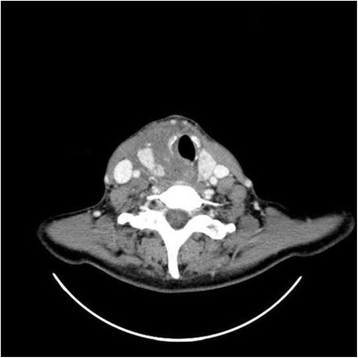Thyroid gland hemorrhage after blunt neck trauma: case report and review of the literature
- PMID: 29183351
- PMCID: PMC5706149
- DOI: 10.1186/s12893-017-0322-y
Thyroid gland hemorrhage after blunt neck trauma: case report and review of the literature
Abstract
Background: Thyroid hemorrhage is considered to be an uncommon complication following blunt trauma to the neck. This condition is potentially life-threatening due to airway compression and may therefore require emergency airway management and surgical intervention in some cases.
Case presentation: We present the case of a 52-year-old woman who experienced a traumatic thyroid gland rupture (right lobe) with subsequent active arterial bleeding from branches of the inferior thyroid artery. On the same day, the patient presented to our emergency department with a painful swelling of the neck with an inspiratory stridor and hoarseness a few hours after a cycling accident. A right hemithyroidectomy was performed. The postoperative course was uneventful. We identified 33 additional cases published in English literature within the last 30 years, reporting blunt trauma to the neck with hemorrhagic complication of the thyroid gland. We provide a systematic review and particularly consider the aspects of endocrine surgery.
Conclusion: The treatment approach for patients with blunt thyroid trauma should be dependent on the extent of the thyroid injury. Patients with tracheal compression, active bleeding and increasing hoarseness/shortness of breath require emergency airway control and often surgical exploration for hemorrhage control followed by resection of the ruptured thyroid. Importantly, in contrast to routine thyroid surgery, no electromyographic endotracheal tube is used during emergency intubation. Exchange of an endotracheal tube should be carefully evaluated due to difficult airway management in this setting. For protection against double-sided recurrent nerve palsy and postoperative hypoparathyroidism, a unilateral approach is preferable whenever possible.
Keywords: Blunt neck trauma; Surgery; Thyroid gland hemorrhage.
Conflict of interest statement
Ethics approval and consent to participate
Written informed consent was obtained from the patient for publication of this Case Report and any accompanying images. A copy of the written consent is available for review by the Editor of this journal.
Consent for publication
Written informed consent was obtained from the patient for publication of this Case Report and any accompanying images. A copy of the written consent is available for review by the Editor of this journal.
Competing interests
The authors declare no conflict of interests.
Publisher’s Note
Springer Nature remains neutral with regard to jurisdictional claims in published maps and institutional affiliations.
Figures


References
-
- Weeks C, Moore FD, Jr, Ferzoco SJ, Gates J. Blunt trauma to the thyroid: a case report. Am Surg. 2005;71:518–521. - PubMed
Publication types
MeSH terms
LinkOut - more resources
Full Text Sources
Other Literature Sources
Medical

